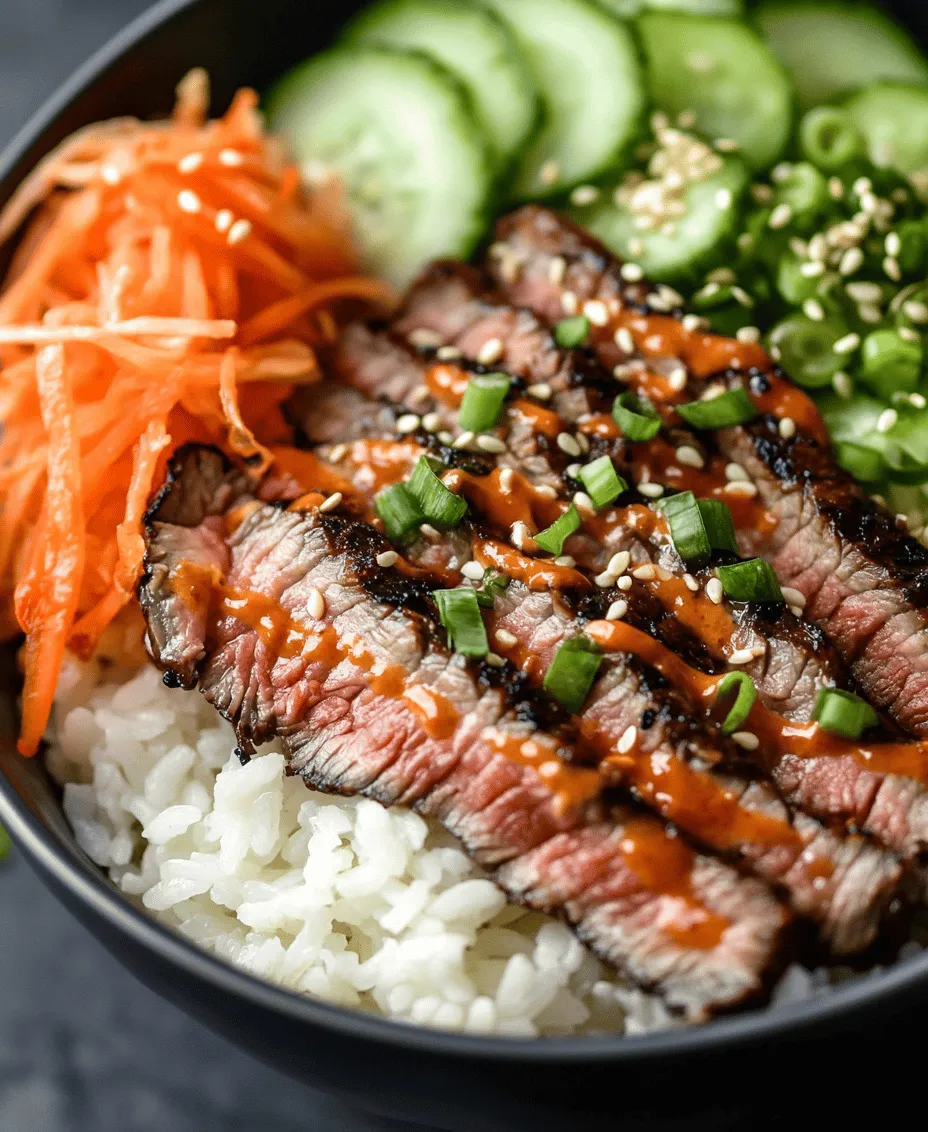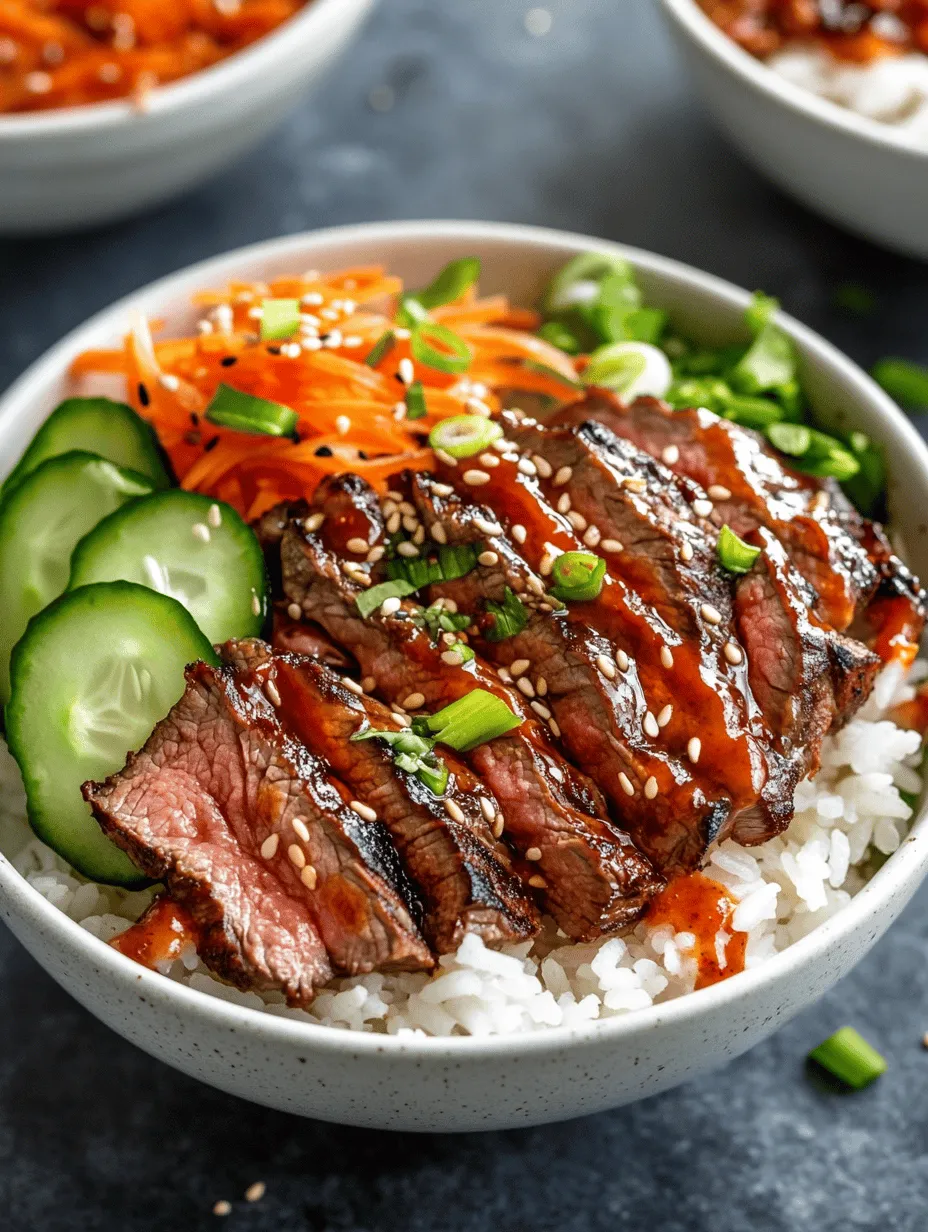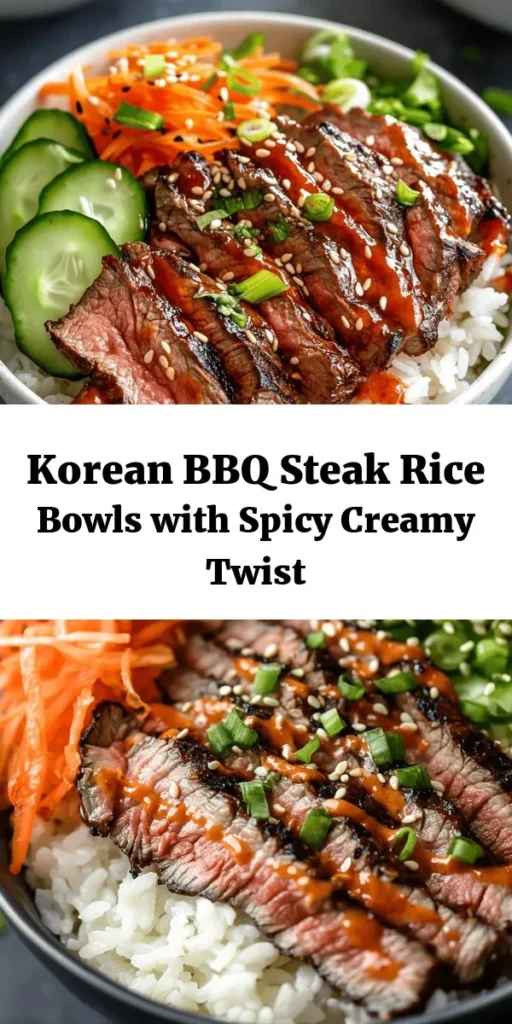Introduction to Korean BBQ Steak Rice Bowls
Korean BBQ Steak Rice Bowls with Spicy Cream Sauce are a delightful fusion of flavors that encapsulate the vibrant tastes of Korean cuisine, bringing a mouthwatering experience right to your table. This dish features tender, marinated flank steak served over a bed of fluffy rice, complemented by the crunch of fresh vegetables and the tangy kick of kimchi, all topped with a rich and spicy cream sauce that elevates each bite. Whether you’re planning a dinner party to impress your guests or seeking a quick yet satisfying weeknight meal, this recipe is sure to become a favorite.
The origins of Korean BBQ can be traced back to traditional Korean grilling methods, where various types of meat are marinated and grilled at the table. This communal cooking style has gained popularity worldwide, leading to innovative adaptations like the steak rice bowl. In this article, we will explore the components of this delectable dish, from the marinade that infuses the steak with flavor to the assembly of the bowl itself, ensuring you have all the information needed to create an authentic and delicious experience in your own kitchen.
Understanding the Key Ingredients
Flank Steak: The Star Protein
Flank steak is the centerpiece of this dish, known for its robust flavor and slightly chewy texture. This cut of beef comes from the abdominal muscles of the cow and is relatively lean, making it a great choice for marinating. When cooked correctly, flank steak can be incredibly tender and flavorful, especially when sliced against the grain. Slicing against the grain is crucial as it breaks up the muscle fibers, resulting in a tender bite that melts in your mouth.
One of the benefits of marinating steak is that it not only enhances the flavor but also helps to tenderize the meat. The marinade penetrates the fibers of the steak, infusing it with the desired flavors while also breaking down the proteins, making the meat more enjoyable to eat. For optimal results, marinate your flank steak for at least 30 minutes, although longer marinating times—up to 12 hours—are recommended for a more intense flavor and improved tenderness.
The Marinade: A Flavor Powerhouse
The marinade for the flank steak is a vital component that brings the unique Korean flavors to life. A traditional Korean BBQ marinade typically includes ingredients such as soy sauce, sesame oil, garlic, ginger, and brown sugar. Each of these ingredients plays a specific role:
– Soy Sauce: Adds umami and saltiness, essential for flavor enhancement.
– Sesame Oil: Imparts a nutty flavor that complements the richness of the beef.
– Garlic and Ginger: Provide aromatic notes and a slight spiciness that are characteristic of Korean cuisine.
– Brown Sugar: Balances the savory elements with sweetness, promoting caramelization during cooking.
The science of marinating relies on time and temperature. The longer the steak marinates, the more flavorful it becomes. However, be mindful of the acidity level in your marinade; too much acid can lead to a mushy texture. A good marinade should be well-balanced, allowing the flavors to meld while retaining the integrity of the meat.
The Rice: A Perfect Base
To accompany the flavorful steak, a bed of rice serves as the perfect base. Jasmine rice is an excellent choice due to its fragrant aroma and slightly sticky texture when cooked. This type of rice pairs beautifully with the other ingredients, providing a neutral canvas that absorbs the flavors of the marinade and sauce.
If you’re looking for variety, consider substituting jasmine rice with other options such as brown rice for added fiber or sushi rice for a stickier consistency. Each type of rice brings its own unique texture and flavor, allowing you to customize your dish to your preference.
Fresh Vegetables: Adding Crunch and Nutrition
Fresh vegetables are an essential part of Korean cuisine, providing not only flavor and texture but also nutritional benefits. In this recipe, we typically include cucumbers, carrots, and scallions.
– Cucumbers: Offer a refreshing crunch and help balance the richness of the steak and sauce. They are also hydrating and low in calories.
– Carrots: Add sweetness and a vibrant color to the dish, contributing vitamins and minerals that enhance your meal’s nutritional profile.
– Scallions: Bring a mild onion flavor and a pop of green, elevating the visual appeal of the rice bowl.
Incorporating these fresh ingredients not only enhances the dish’s flavor but also ensures a well-rounded meal that satisfies both the palate and nutritional needs.
Kimchi: A Traditional Korean Staple
No Korean dish is complete without kimchi, a staple in Korean cuisine known for its complex flavors and health benefits. Kimchi is a fermented dish made primarily from napa cabbage and Korean radishes, seasoned with a variety of spices, garlic, ginger, and sometimes red pepper flakes for heat.
The cultural significance of kimchi in Korea is profound; it represents a connection to heritage and tradition, often served at every meal. Beyond its cultural importance, kimchi is rich in probiotics, which are beneficial for gut health, and provides a tangy contrast to the savory flavors of the steak and rice.
There are many variations of kimchi available, from store-bought to homemade. While store-bought options can be convenient, making your own allows for customization of spice levels and flavor profiles, giving you the perfect accompaniment to your Korean BBQ Steak Rice Bowls.
The Spicy Cream Sauce: A Flavorful Finishing Touch
To complete your Korean BBQ Steak Rice Bowls, a spicy cream sauce adds a luscious and flavorful finishing touch. This sauce typically combines ingredients such as mayonnaise, gochujang (Korean chili paste), lime juice, and a touch of honey or sugar.
The balance of flavors in the spicy cream sauce is crucial; it should be spicy enough to provide a kick, sweet enough to balance the heat, and tangy enough to cut through the richness. Adjust the spice levels to your liking by adding more or less gochujang; this flexibility allows you to tailor the dish to your taste.
This creamy sauce not only enhances the overall flavor profile of the dish but also adds a beautiful, inviting appearance that makes your rice bowls even more appetizing.
Step-by-Step Instructions for Preparation
Preparing the Steak Marinade
Now that we’ve discussed the key ingredients and their significance, let’s dive into the preparation of the steak marinade. Follow these detailed instructions to ensure your flank steak is perfectly marinated and bursting with flavor:
1. Gather Your Ingredients: To prepare the marinade, you will need the following:
– 1/4 cup soy sauce
– 2 tablespoons sesame oil
– 3 cloves garlic, minced
– 1 tablespoon fresh ginger, grated
– 2 tablespoons brown sugar
– 1 tablespoon rice vinegar (optional for added acidity)
2. Mix the Marinade: In a medium-sized bowl, combine the soy sauce, sesame oil, minced garlic, grated ginger, brown sugar, and rice vinegar (if using). Whisk the mixture until the sugar is dissolved and all ingredients are well incorporated.
3. Marinate the Steak: Place your flank steak in a large resealable plastic bag or a shallow dish. Pour the marinade over the steak, ensuring it is evenly coated. Seal the bag or cover the dish with plastic wrap.
4. Refrigerate: For optimal flavor, refrigerate the marinating steak for at least 30 minutes. If time allows, marinating overnight will yield even better results. Just be cautious not to exceed 12 hours to prevent the meat from becoming too soft.
5. Prepare for Cooking: Once the marinating time is complete, remove the flank steak from the refrigerator and allow it to sit at room temperature for about 15 minutes before cooking. This helps the steak cook more evenly.
By following these steps, you’ll create a flavorful base for your Korean BBQ Steak Rice Bowls. In the next part of this article, we will explore the remaining components of the dish, including cooking the steak to perfection, preparing the rice, and assembling the final bowl. Stay tuned for a delicious culinary journey that will bring the essence of Korean BBQ to your dinner table.

Cooking the Steak to Perfection
To achieve the best flavor and texture in your Korean BBQ Steak Rice Bowls, cooking the steak to perfection is crucial. Here’s how to ensure your steak is grilled just right.
Tips for Preheating the Grill or Grill Pan
Before you even think about placing the steak on the grill, it’s essential to preheat it properly. Whether using a traditional outdoor grill or a grill pan indoors, here are steps to ensure optimal cooking:
1. Clean the Grill Grates: Start with a clean surface. Scrape off any residue from previous grilling sessions to prevent sticking.
2. High Heat: Preheat your grill or grill pan over medium-high heat for at least 5-10 minutes. This high temperature will give you a nice sear on the steak, locking in juices and flavors.
3. Oil the Grates: Use a paper towel soaked in oil to lightly coat the grill grates. This helps to prevent the steak from sticking and ensures those beautiful grill marks.
4. Use an Instant-Read Thermometer: For the best results, keep an instant-read thermometer on hand to check the internal temperature of the steak.
Visual Cues for Determining Steak Doneness
Cooking steak to the right doneness is a matter of personal preference, but knowing the visual cues can help you achieve your desired result:
– Rare: The steak will have a deep red center and will be soft to the touch. It should register at 125°F (52°C).
– Medium Rare: The center will be warm and pink, firming up slightly. Aim for 135°F (57°C).
– Medium: A light pink center with a firmer texture, ideally around 145°F (63°C).
– Medium Well: The steak will be mostly brown with a hint of pink in the center, reaching 150°F (66°C).
– Well Done: No pink at all, with a firm texture. This will be above 160°F (71°C).
Resting Steak: Why It Matters
After grilling, let the steak rest for at least 5-10 minutes before slicing. This resting period allows the juices to redistribute throughout the meat, preventing them from spilling out when you cut into it. It results in a more flavorful and tender steak. Cover it loosely with aluminum foil to keep it warm during this time.
Making the Spicy Cream Sauce
The spicy cream sauce is the star of the dish, adding a rich, zesty flavor that complements the savory steak.
Instructions for Achieving a Smooth Consistency
1. Gather Ingredients: Combine sour cream, mayonnaise, gochujang (Korean chili paste), minced garlic, lime juice, and a pinch of salt in a mixing bowl.
2. Whisk Together: Use a whisk or a fork to mix the ingredients thoroughly. The goal is a smooth and creamy texture, so ensure there are no lumps from the gochujang.
3. Adjust Consistency: If the sauce is too thick, add a teaspoon of water or milk to achieve your desired consistency. Whisk again until smooth.
4. Taste and Adjust: Before serving, taste the sauce and adjust seasoning as needed, adding more lime juice for acidity or more gochujang for heat.
Suggestions for Variations in the Sauce
Feel free to customize the spicy cream sauce to suit your taste. Here are a few variations you might consider:
– Herbed Version: Add fresh chopped cilantro or green onions for an herbal note.
– Smoky Flavor: Incorporate a bit of smoked paprika or chipotle powder for a smoky kick.
– Tangy Twist: Mix in some kimchi juice for added tang and depth.
Assembling the Rice Bowls
The final step is to assemble your Korean BBQ Steak Rice Bowls. This is where you can get creative with presentation and flavor balance.
Layering Techniques for Visual Appeal
1. Base Layer: Start with a generous scoop of cooked rice at the bottom of each bowl. You can use jasmine rice, short-grain rice, or even cauliflower rice for a low-carb option.
2. Steak Slices: Thinly slice the rested steak against the grain and layer it on top of the rice. Aim for an even distribution for visual balance.
3. Vegetables: Add a colorful array of toppings such as sliced cucumbers, shredded carrots, and radishes for crunch and freshness.
4. Pickled Ingredients: Consider adding some pickled daikon or kimchi for a hit of acidity and flavor contrast.
Balancing Flavors and Textures in Each Bowl
To create a well-rounded dish, ensure that each component complements the others. The creaminess of the spicy sauce balances the savory steak, while the fresh vegetables add crunch and brightness. Don’t forget to include a sprinkle of sesame seeds for extra texture and flavor.
Drizzling the Spicy Cream Sauce
Once your bowls are assembled, it’s time to finish them with the spicy cream sauce.
Technique for Drizzling the Sauce for Presentation
For a beautiful presentation, transfer the spicy cream sauce to a squeeze bottle or a small zip-lock bag with the corner snipped off. This allows for precise control when drizzling the sauce over the assembled bowls.
1. Start from One Side: Begin at one side of the bowl and drizzle in a zigzag pattern across the surface.
2. Add Depth: For a gourmet touch, consider layering the sauce in a few places to add depth and visual interest.
Optional Garnishes to Enhance Flavor and Aesthetics
To elevate your rice bowls further, consider garnishing with:
– Chopped Green Onions: For a fresh, oniony flavor that adds color.
– Sesame Seeds: Toasted sesame seeds can enhance flavor and provide crunch.
– Microgreens or Cilantro: Fresh herbs add a pop of color and freshness.
Serving Suggestions and Pairings
To round out your meal, consider these beverage pairings and side dishes that complement your Korean BBQ Steak Rice Bowls.
Beverage Pairings
1. Traditional Korean Beverages:
– Soju: This popular Korean distilled spirit is a great match for BBQ flavors.
– Makgeolli: A traditional Korean rice wine that offers a slightly sweet flavor.
2. Non-Alcoholic Options:
– Iced Green Tea: A refreshing option that complements the richness of the steak.
– Sparkling Water with Lime: This can cleanse the palate between bites.
Side Dishes to Enhance the Meal
To create a complete Korean dining experience, consider these traditional banchan (side dishes):
– Kimchi: A staple in Korean cuisine, it adds a spicy and tangy flavor that pairs well with the rich steak.
– Korean Potato Salad: A slightly sweet and creamy side that balances the meal.
– Cucumber Salad: A light and refreshing option that provides a crunch.
Nutritional Information and Benefits
Understanding the nutritional aspects of your dish can help you enjoy it guilt-free.
Caloric Breakdown
– Steak: Depending on the cut, a serving of beef can range from 200-300 calories.
– Rice: A cup of cooked rice contributes approximately 200 calories.
– Spicy Cream Sauce: Each serving of the sauce may add around 100-150 calories.
Altogether, a complete bowl can provide a satisfying meal around 600-800 calories, depending on portion sizes.
Nutritional Benefits of the Dish
This dish provides a balance of protein, carbohydrates, and healthy fats. The beef offers essential amino acids, while the vegetables contribute vitamins and minerals. The spicy cream sauce contains probiotics if you use fermented ingredients like kimchi.
Dietary Considerations
1. Gluten-Free Options: Substitute soy sauce with tamari or coconut aminos to make this dish gluten-free.
2. Low-Carb Adaptations: Use cauliflower rice instead of traditional rice for a low-carb version.
3. Vegetarian or Vegan Options: Replace the steak with marinated tofu or tempeh and use plant-based yogurt for the sauce.
Conclusion: Enjoying the Experience of Korean BBQ Steak Rice Bowls
Korean BBQ Steak Rice Bowls with Spicy Cream Sauce offer a delightful culinary experience that perfectly embodies the vibrant flavors of Korean cuisine. The combination of savory steak, a creamy, spicy sauce, and fresh vegetables creates a satisfying meal that is both visually appealing and delicious.
By following these detailed steps, you can master the art of creating this dish in your kitchen. Whether you’re prepping for a family dinner or hosting a gathering with friends, these rice bowls are sure to impress. Embrace the bold flavors and enjoy the process of cooking, knowing that each bite will be a rewarding experience. Whether shared with loved ones or savored solo, this recipe will undoubtedly become a cherished addition to your culinary repertoire.



